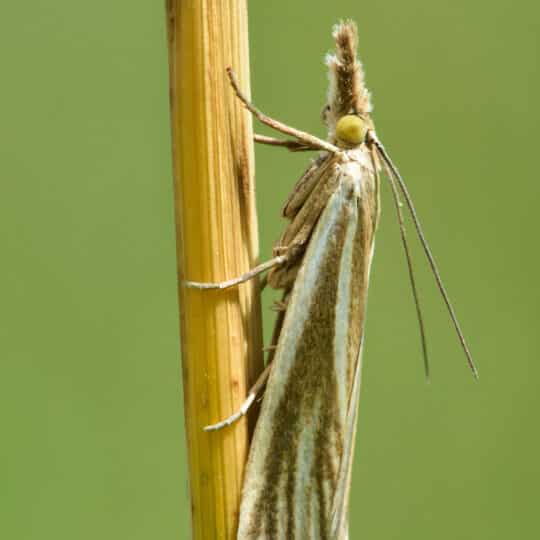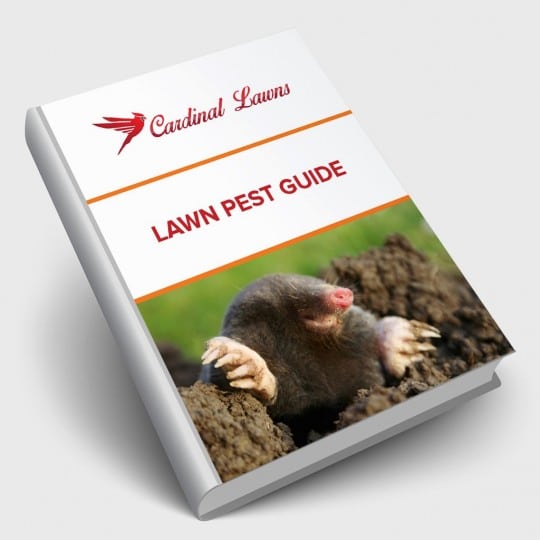How to Tell if Sod Webworms are Eating Your Lawn
And What to do About it
Posted
October 17, 2024

Even though the weather is turning cooler and many insects aren’t as active, there are still several lawn pests to watch out for in the fall. Sod webworms are one species that can cause significant damage to your lawn this time of year. Learn the signs of sod webworms and how to protect your yard.
Signs of Sod Webworms
While it may be easier to spot the small moth flying low over the grass, it’s the larvae that feed on the blades at night. This creates irregular brown patches in your lawn that may seem like drought damage. But if you’ve been watering regularly and still notice an issue, it may be a pest problem instead.
These lawn pests are active in the late summer and throughout the fall. They’re drawn to areas weakened by heat or drought, which is what could cause the initial misdiagnosis. But there are other telltale signs:
- Pale green to light brown caterpillars with dark spots
- Silk-lined tunnels or “webs” in lawn thatch
- Clumps of frass (insect excrement) near the base of the grass
- Small beige or gray moths that fly around at night in a zig-zag pattern to lay eggs
- Chewed grass blades
Once you notice any of these signs, it’s time to take action to help prevent further damage.
Treating Your Lawn for Sod Webworms
Before using any kind of treatment on your grass, it’s best to make sure you’re dealing with sod webworms. Any other pest or lawn disease may require alternative methods. Contact a lawn care expert to help diagnose the issue. You can also try this soap test to determine the extent of the infestation:
- Mix a tablespoon of dish soap in a gallon of water and pour it over a suspected area.
- The soapy solution irritates the larvae, causing them to surface within a few minutes.
- If you don’t see any caterpillars after testing the area, get a second opinion before applying insecticides, as it could be a waste of time and money.
If you do see sod webworms surface after the soap trick, use a granular or liquid product designed to treat this specific pest. Apply at night when the pests are more active. Lightly water the lawn after application to help move the product through the thatch layer.
Pest Prevention
Once you’ve dealt with lawn pests, there are certain practices that help ensure they won’t return. One of the best ways to prevent pests and disease is to maintain a healthy lawn. Since most problems stem from weakened grass, you can help strengthen it and make it more resilient.
- Proper watering. Grass needs about an inch of water a week. It’s better to water deeply than frequently. This helps promote deep root growth, which is the foundation of a healthy lawn.
- Proper mowing. Only cut when needed and keep your grass a few inches tall to shade the soil and reduce stress.
- Aerate. Not only does this help reduce soil compaction—making it easier for grass roots to receive water and nutrients—but it also reduces thatch buildup where sod webworms reside.
- Fertilize. Promote healthy root and grass growth to help make your lawn more resistant to pest damage. Avoid over-fertilizing with nitrogen, as this can actually attract sod webworms.
- Prevent moths. Install outdoor lights that won’t attract insects, like the adult moths looking to breed and lay sod webworm eggs. Some traps are also designed used to capture moths.
By maintaining a healthy lawn and treating at the first signs of damage, you can effectively manage sod webworms and prevent widespread destruction of your turf. Contact Cardinal Lawns to help determine if you have a pest or disease problem. Our lawn care specialists can then create a plan to treat and prevent problems in the future.

Download Your FREE Lawn Pest Guide
Pests become most prevalent during the heat and humidity of summer. Take some time to learn about the signs of infestations before any damage can be caused to your landscape. This handy guide will teach you how to spot common lawn pests and how to keep them from causing harm to you and your property.